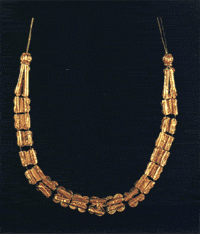
|
GOLD
Length 15.5 cm. ; diameter of spiral-form beads 0.7 cm. ; weight
6.4 gr.
USAK MUSEUM
The necklace is composed of a total of twenty-one beads of four
different kinds -seventeen quadruple spirals of two kinds, two
of a slender 'lyre' motif, and two melon beads. Both kinds of
quadruple spirals are made from two lengths of block twist gold
wire with each end coiled into a spiral and placed in a 'clover
leaf' arrangement, In the centre of each spiral is a granular
sphere, and there is a fifth in the centre of the 'clover leaf,
In six examples the wire that forms each pair of spirals has an
Scurve and the central granule is secured by a wire frame, In
the other eleven examples the spiral pairs are formed like Ionic
capitals and mounted on a square plaque of sheet, the outer curve
of each spiral outlined by tiny granulation spheres, and with
no wire frame around the central granule, Both upper and lower
pair of coils are soldered to a plain cylindrical tube of sheet.
through each of which the necklace was threaded. The 'lyre' beads
are also formed of filigree wire mounted on a plaque of sheet
and outlined by granulation. The spirals at the narrow end of
each bead coil outwards, those at the broad end coil inwards,
Both have inner ornamentation where the spirals at either end
join; on one bead the ornamentation consists of wire loops, on
the other of granulation clusters.
|
Two
cylindrical tubes attached to the back of each plaque are placed
at an
angle, touching at the narrow end, Where the two threads of the
necklace emerge close together and pass through a melon bead Which
has a ring of hammered. square-section twisted wire around each
perforation.
The quadruple spiral motif has a long history in the jewellery of
Anatolia and the Near East, beginning in the 3rd millennium BC (at
Troy, Alacahöyük and, later. Kultepe-Kanesh in Anatolia, and Tell
Brak, Ur, Mari and other Mesopotamian sites) and continuing in northwest
Iran, at Marlik and Ziwiye. into the 7th century BC. In all those
examples. however, the spirals are associated with a tubular stem
from which the wires spring or to which they are fastened.
|
|
|









